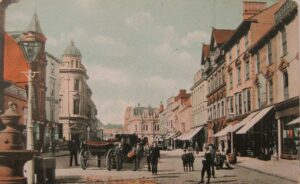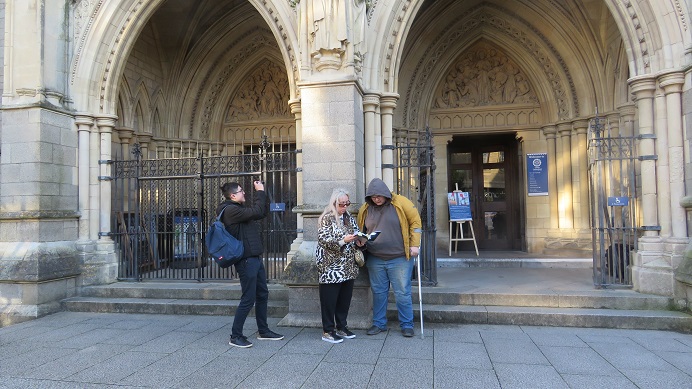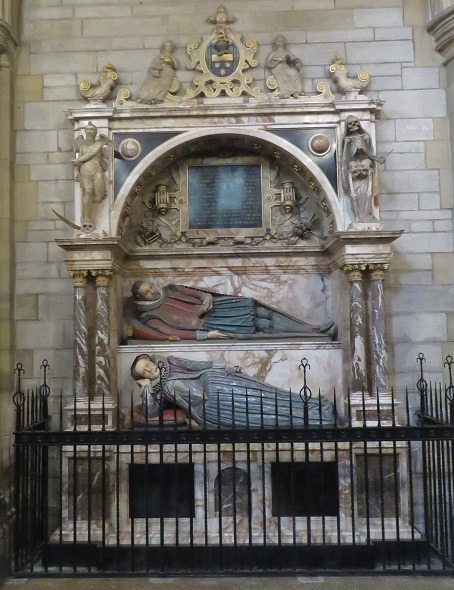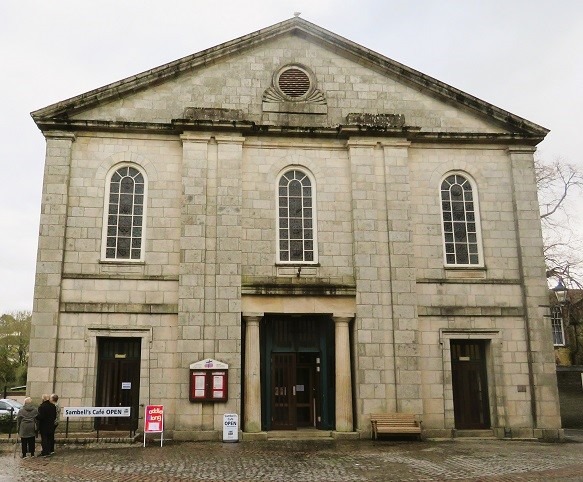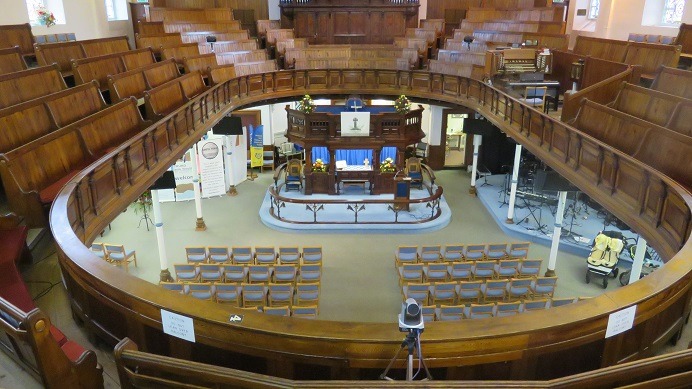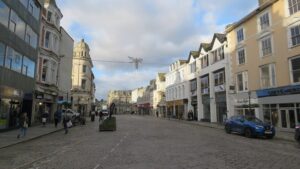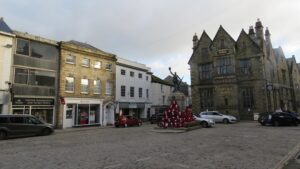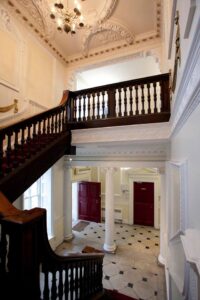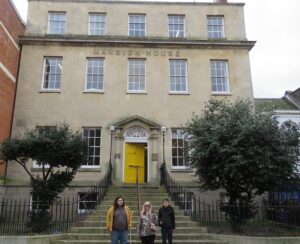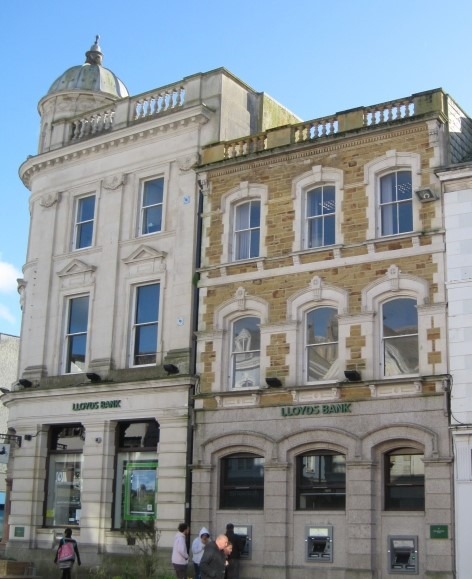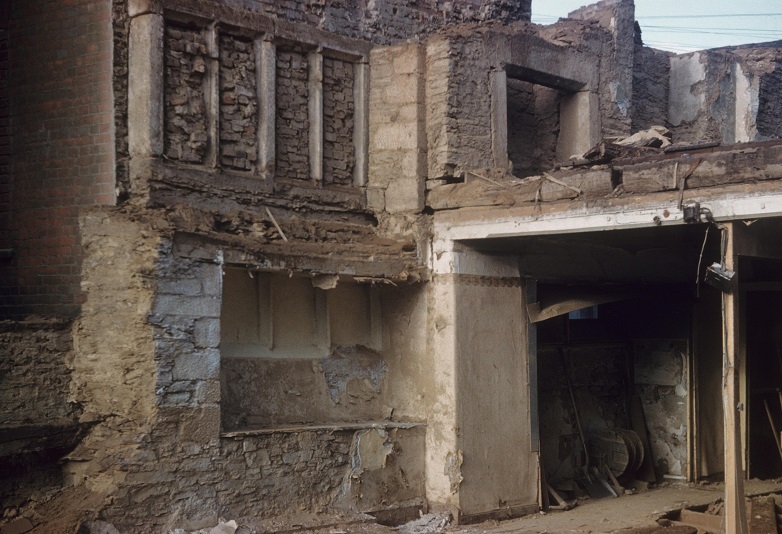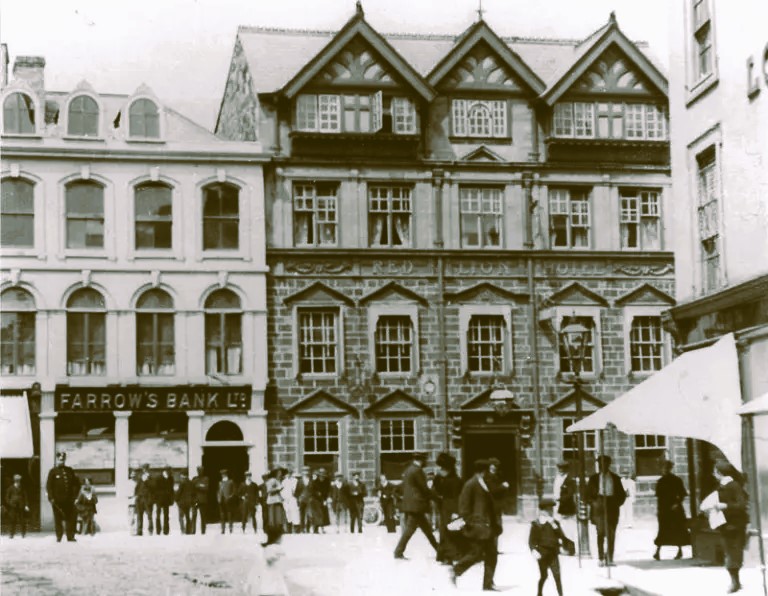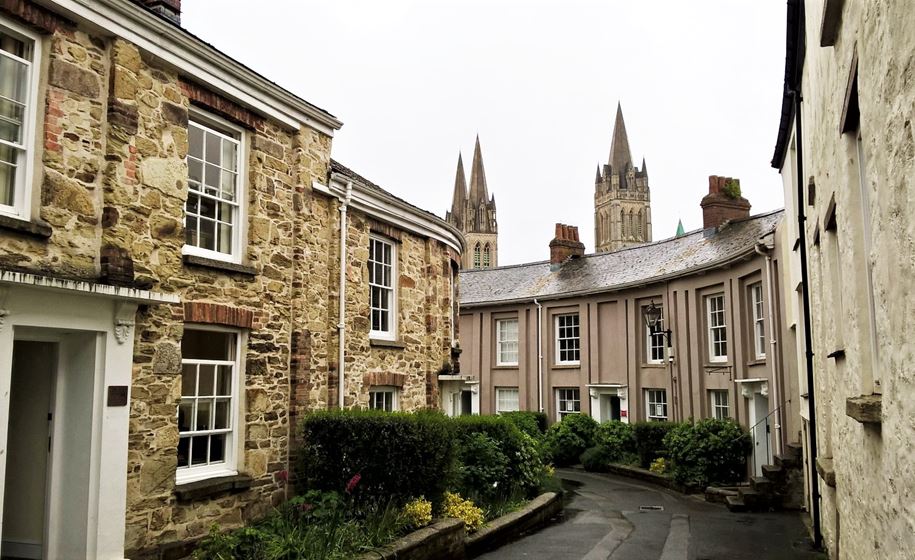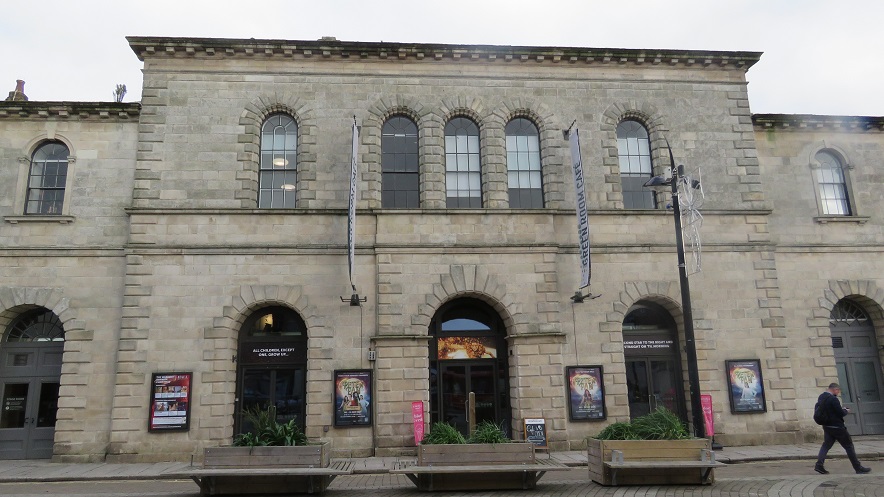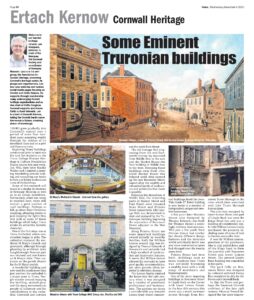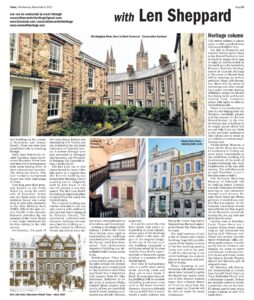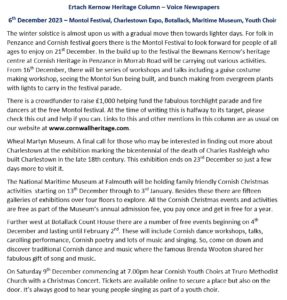Ertach Kernow - Some eminent Truronian buildings
Truro grew gradually into Cornwall’s capital over a period of some four hundred years acquiring wealth through the actions of its merchant class and as a port and Stannary town. Exploring Truro’ buildings constructed prior to 1900 was the task for students on the Truro College History Heritage & Culture Foundation Degree course this past week. Joe, Will, their tutor Marilla Walker and I enjoyed a morning wandering around looking and consulting our books to date and better understand some of the buildings. Some of this research will result in a display by students at Newquay Museum as well as in an online exhibition. Fortunately, albeit too many to mention here, there still remain a good number of such buildings. Perhaps as folk go about their Christmas shopping, attending events or just enjoying the lights they will look at some of these buildings which helps Truro retain its attractive historic character.
One of the first stops was at Truro Cathedral where construction began in 1880. The cathedral replaced the medieval St Mary’s Church and graveyard, although through planning by architect John Loughborough Pearson part was retained and now known as St Mary’s Aisle. This continues as the parish church for the St Mary’s parish. A wonderful building and now used for much more than just services the cathedral is a major asset to Truro. People wander around enjoying the building, stained glass and the many monuments to people of influence and for contributions to the cathedral, Cornwall and Cornish heritage and culture. See the memorials to folk mentioned over the past in these articles, Sir Arthur Quiller Couch, A L Rowse, Charles Henderson, the Robartes ancestors with their magnificent memorial. Sadly, some remain hidden away including that to Owen Fitzpen, once in St Mary’s, a reminder that during the 16th and 17th century Cornish folk were taken from their vessels and coastal villages by north African barbary pirates and sold into slavery.
Close by the cathedral lies the Truro Methodist Church. Built as St Mary’s Wesleyan Chapel to accommodate an increasing Methodist community this fine building was designed by the deaf-disabled Truro architect Philip Sambell. Although through his deafness Sambell was unable to communicate verbally he was a highly intelligent man who had a number of his reports read at the Royal Institution of Cornwall. Happily, he is now being better recognised through identification of some of his works within Truro. The Methodist chapel was begun in June 1829 and was opened in July 1830 being further extended in 1867 with the addition of a Sunday school. Between 1884 and about 1887 it was remodelled, refitted and had an additional assembly hall, classrooms, committee rooms and vestries added. These were designed by local architect Sylvanus Trevail. This is a fine building and from our visit seems much used by local people especially within the Sambell refreshment area.
As always click the image for larger view
Truro’s primary street with its many side roads is Boscawen Street. As one looks along it most will be unaware that at one time this broad open area was once split down the centre by a row of what were described prior to their demolition as dilapidated houses, known as Middle Row. On either side of the properties in Middle Row lay to the north Market Street and the south Fore Street. The old Coinage Hall originating from the mid-fourteenth century lay separated from Middle Row to the east and the Market House the final building in Middle Row to the west. Sweeping these buildings away from 1790, albeit Market House was delayed until 1809 opened up the new Boscawen Street named after the wealthy and influential family of landowners and politicians that made it possible. Following the demolition of Middle Row, the remaining parts of Market Street and Fore Street were renamed Duke Street and Princes Street respectively. Old Coinage Hall was demolished in 1848 and replaced by the Tudoresque building beginning the separation of Boscawen Street adjacent to the War Memorial.
Along Princes Street are some important buildings owned initially by wealthy families. Princes House built for William Lemon around 1739 was designed by Thomas Edwards of Greenwich and certainly had a high standard of construction and impressive features. It seems that William Lemon allowed his servants to have good quality accommodation, not attic garrets often depicted in television dramas. The Lemon family retained the house into the 19th century when it was occupied by a number of prominent professional and businessmen. The gardens ran down a considerable way towards Lemon Quay where commercial buildings lined the river. This Grade II* listed building is now home to a number of independent unique and creative businesses. A few years later Mansion House also designed by Thomas Edwards was built for Thomas Daniel a seemingly ruthless businessman. This just a few yards from Princes House had similar but clearly different design features and the interiors whilst artistically lavish was also more restrained as tastes had changed over the twenty years since Princes House had been built. Buildings such as these illustrate that Truro was certainly becoming a wealthy town with a wide range of merchants and businesspeople.
One of the more imposing buildings in Boscawen Street is Lloyds Bank on the Corner with lower Lemon Street. In the late 18th century this street was a much narrower access through from Boscawen Street through to the river which then stretched well into Truro through Lemon Quay. The area now occupied by lower Lemon Street and part of Lloyds Bank was once the Kings Head Inn and was a building of considerable size. In 1760 William Lemon family purchased the property including some 26 acres of land to the rear across the river. It was Sir William Lemon, grandson of the purchaser, who in 1797 pulled down part of the Kings head to form the junction with Boscawen Street and lower Lemon Street. The present Lloyds Bank building was completed in two parts. The part fully on Boscawen Street was designed by Liskeard architect Henry Rice completed in 1872 for the Devon and Cornwall Bank. In 1891 the Truro and perhaps the foremost Cornish architect of the late 19th century Silvanus Trevail designed the far more impressive building on the corner of Boscawen and Lemon Street’s. These two were then joined internally by knocking through.
Sadly, some historically valuable buildings along the renamed Boscawen Street have now been lost to development with some having little of their construction recorded. The Robartes family who later resided at Lanhydrock House had their beginnings in Truro. Now long gone their property known as the Great House lay along the north side of Boscawen Street and the final parts of this medieval house was swept away in 1960 with extension to the then Midland Bank (HSBC). Behind the 19th century façade to the adjacent Pearson’s Jewellers lay the remains of the Great House a very large townhouse for its time dating to the 16th century. Fortunately, this part of the Great House history was recorded by J W Tonkin and can be found in the 1961 Royal Institution of Cornwall journal. A number of images were also recorded by Newquay photographer, and President of Newquay Old Cornwall Society, Charles Woolf.
The Red Lion Inn is still remembered by many older folk and it is a tragedy that this historic building was demolished following a lorry crashing into it. Originally built by John Foote in the late 17th century it was later named ‘The Red Lion Hotel’ becoming an important place to stay in Truro for nearly two hundred years. The original building was further extended in the late 19th century with additional 2nd and top floors designed by Silvanus Trevail. The renowned architectural historian Nikolaus Pevsner described the building as ‘…terribly treated by Silvanus Trevail, has still its lower stories of 1671, with pediments to all windows, and its staircase’. Looking at the images of the damage I believe the Truro Civic Society were right in questioning the buildings total destruction and whether the façade could have been saved. This historically important building was demolished with it seems undue haste.
The site of Walshingham Place has a long history going back to the 15th century the current buildings were constructed in 1837 and were saved from post-World War II demolition with support from Sir John Betjeman. Believed to be the work of architect Philip Sambell these houses, now mainly offices are thankfully Grade II listed, forming an attractive run of early Victorian properties. It must be noted that the lions heads that adorn or, depending on your opinion, deface some of the buildings were added in the 1960, not part of the original design. At the top of the row is an old building originally a malthouse owned by the once wealthy Enys family apparently lost to them over a game of poker to a member of the Mallett family. Over time it had multiple uses as a coffin store, dance room, meeting room and shop and is also Grade II listed.
So many more interesting buildings still to consider including prominent ones such as the Royal Cornwall Museum, Passmore Edwards Library and Hall for Cornwall, which I sadly noticed was flying the Union flag rather than perhaps the more appropriate Baner Sen Peren given its name 'Hall for Cornwall'. This brief overview of just a few of Truro’s city central buildings hopefully provides a taste of the history of some of the fine buildings gracing Truro now and in the past.
It will be interesting to see which buildings the students choose to research and publish for display. Those shopping or just browsing will perhaps think about how Cornwall’s capital developed and maybe book one of Bert Biscoe’s walking tours. Bert a former Mayor of Truro has many hats, but as an expert on Truro he will be able to share far more information.
As at 6th December 2023 click the link for Bert's walking tour of Truro: Bert Biscoe's Walking Tours - Things to do in Truro, Cornwall
